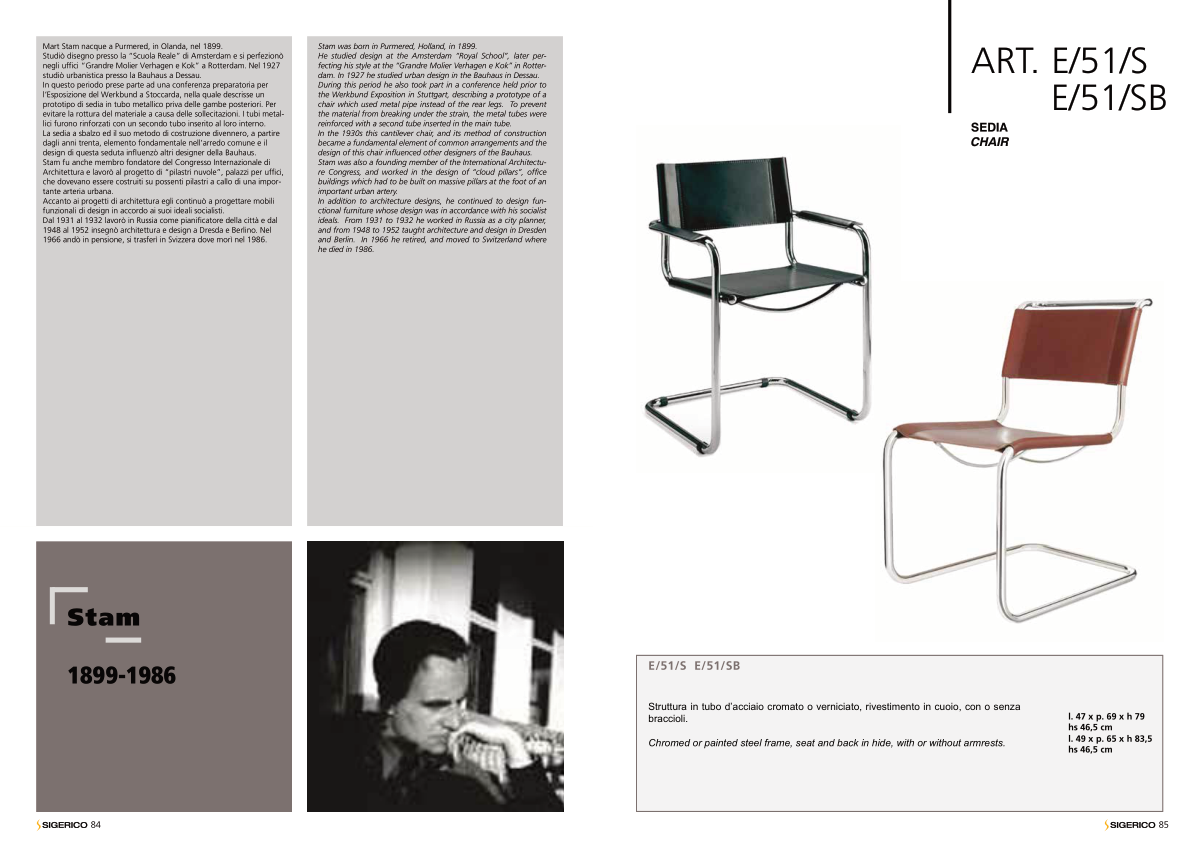Stam
1899-1986
Mart Stam nacque a Purmered, in Olanda, nel 1899.
Studiò disegno presso la “Scuola Reale” di Amsterdam e si perfezionò
negli uffici “Grandre Molier Verhagen e Kok” a Rotterdam. Nel 1927
studiò urbanistica presso la Bauhaus a Dessau.
In questo periodo prese parte ad una conferenza preparatoria per
l’Esposizione del Werkbund a Stoccarda, nella quale descrisse un
prototipo di sedia in tubo metallico priva delle gambe posteriori. Per
evitare la rottura del materiale a causa delle sollecitazioni. I tubi metal-
lici furono rinforzati con un secondo tubo inserito al loro interno.
La sedia a sbalzo ed il suo metodo di costruzione divennero, a partire
dagli anni trenta, elemento fondamentale nell’arredo comune e il
design di questa seduta influenzò altri designer della Bauhaus.
Stam fu anche membro fondatore del Congresso Internazionale di
Architettura e lavorò al progetto di “pilastri nuvole”, palazzi per uffici,
che dovevano essere costruiti su possenti pilastri a callo di una impor-
tante arteria urbana.
Accanto ai progetti di architettura egli continuò a progettare mobili
funzionali di design in accordo ai suoi ideali socialisti.
Dal 1931 al 1932 lavorò in Russia come pianificatore della città e dal
1948 al 1952 insegnò architettura e design a Dresda e Berlino. Nel
1966 andò in pensione, si trasferì in Svizzera dove morì nel 1986.
Stam was born in Purmered, Holland, in 1899.
He studied design at the Amsterdam “Royal School”, later per-
fecting his style at the “Grandre Molier Verhagen e Kok” in Rotter-
dam. In 1927 he studied urban design in the Bauhaus in Dessau.
During this period he also took part in a conference held prior to
the Werkbund Exposition in Stuttgart, describing a prototype of a
chair which used metal pipe instead of the rear legs. To prevent
the material from breaking under the strain, the metal tubes were
reinforced with a second tube inserted in the main tube.
In the 1930s this cantilever chair, and its method of construction
became a fundamental element of common arrangements and the
design of this chair influenced other designers of the Bauhaus.
Stam was also a founding member of the International Architectu-
re Congress, and worked in the design of “cloud pillars”, office
buildings which had to be built on massive pillars at the foot of an
important urban artery.
In addition to architecture designs, he continued to design fun-
ctional furniture whose design was in accordance with his socialist
ideals. From 1931 to 1932 he worked in Russia as a city planner,
and from 1948 to 1952 taught architecture and design in Dresden
and Berlin. In 1966 he retired, and moved to Switzerland where
he died in 1986.
ART. E/51/S
SEDIA
CHAIR
E/51/SB
Struttura in tubo d’acciaio cromato o verniciato, rivestimento in cuoio, con o senza
braccioli.
Chromed or painted steel frame, seat and back in hide, with or without armrests.
l. 47 x p. 69 x h 79
hs 46,5 cm
85
84
l. 49 x p. 65 x h 83,5
hs 46,5 cm
E/51/S E/51/SB


